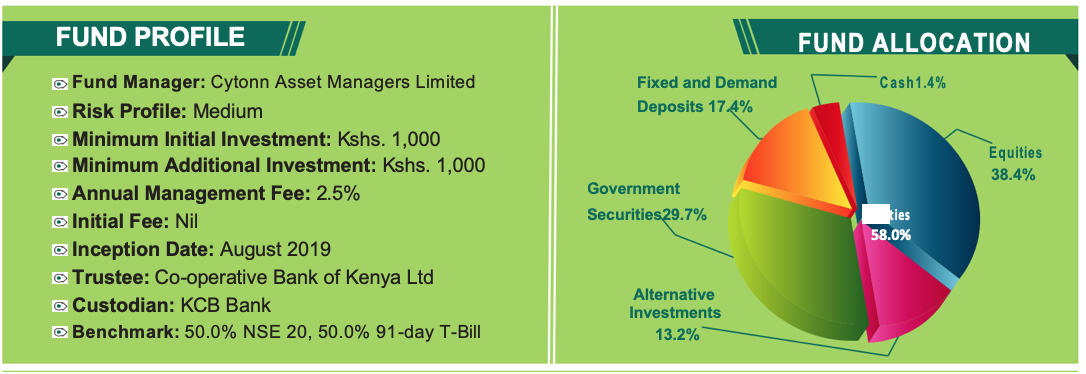1. FUND PERFOMANCE

*Aggregate percent amount that your investment would have gained since the fund started (01-August-2019)
**Percentage you can expect to earn with the fund during one year of investment on basis of the so far realized monthly returns.
2. FUND MANAGER’S REPORT AND OUTLOOK
Fund Objective
The Cytonn Balanced Fund is a medium-risk fund that seeks to achieve a reasonable level of current income and o er investors long-term capital growth.
Portfolio Strategy
The fund seeks to outperform the weighted returns from both fixed income instruments and the Equities listed in the Nairobi Securities Exchange. This is achieved by both optimizing asset allocation and security selection. The fund will therefore be invested in a diversified set of securities ranging from equities, fixed income, and collective investments schemes among others.
Portfolio Performance
The Cytonn Balanced fund recorded gains of 1.2% in the month of June 2020. The 1.2% gain in the fund's performance was mainly driven by gains recorded in KCB Group and Safaricom’s shares of 2.5% and 0.4% as well as gains in the fixed income securities. The gain was however, weighed down by losses recorded in Equity Group of 1.6%. The equities market recorded mixed performance, with both NASI and NSE 25 gaining by 0.4%, while NSE 20 declined by 0.3%. The NASI performance was driven by gains recorded by large cap stocks such as KCB, Standard Chartered Bank, Safaricom and EABL of 2.5%, 2.3%, 0.4% and 0.3%, respectively. The yields on the 91-day, 182-day, and 364-day papers declined by 0.6% points, 0.8% points, and 1.0% points, respectively, to 6.7%, 7.4%, and 8.2%, respectively, in June, from 7.3%, 8.2% and 9.2%, respectively, recorded in May.
Economic report and outlook
Economic growth has remained subdued due to the ongoing COVID-19 pandemic, which has disrupted various sectors. According to the recent pronouncement, from the June Monetary Policy Committee press release, most recent economic indicators points that growth in Q1’2020 was strong, as the impact of COVID-19 virus was majorly pronounced in April 2020. There was however a notable recovery in the economy in May 2020 driven by increased agricultural output and exports. There has been pressure on interest rates with the yield curve shifting upwards from the December levels, which has seen the FTSE NSE Kenya Government Bond Index shed 1.0% YTD, this is despite a cumulative 1.5% points’ downward revision of the Central Bank Rate (CBR) since the beginning of the year to the current rate of 7.0%. On the short end of the yield curve, the Central Bank of Kenya has managed to maintain the yields relatively stable with the 91 day T-Bill declining to 6.7% in June, from 7.3% recorded in May. Inflation has remained within the Central Bank’s target of between 2.5% and 7.5%, with the June inflation coming in at 4.6% a decline from 5.3% in May, driven by a 1.3% decline in the food and non-alcoholic drinks’ Index, coupled with a 0.8% decline in the housing, water, electricity, gas and other fuels’ index. Slight pressure has been recorded on the Kenyan Shilling on the back of increased dollar demand from merchandise importers as the easing of coronavirus restrictions jumpstart economic activities, thus boosting demand for hard currency but we do not foresee further declines as the Central Bank remains active in the market to cushion the shilling.
The Nairobi securities markets recorded a 0.3% decline in the month of June as measured by the Nairobi All Share Index. With the market trading at valuations below the historical average, the valuations are now significantly attractive with the current market price to earnings ratio (P/E) at 8.2x, which is 37.2% below the historical average of 13.1x, and the dividend yield is at 5.1%, 1.1% points above the historical average of 4.0%.

Disclaimer: Past performance is not a guarantee of future performance and the value of the fund will fluctuate from time to time.



